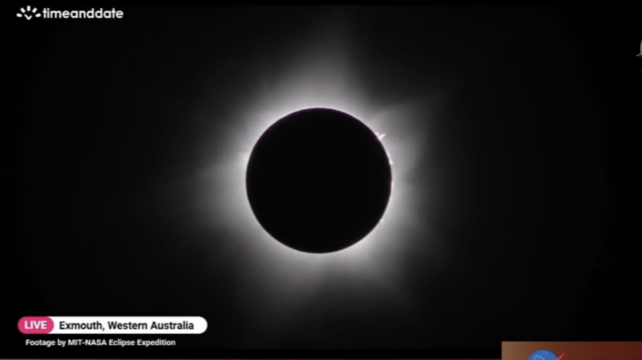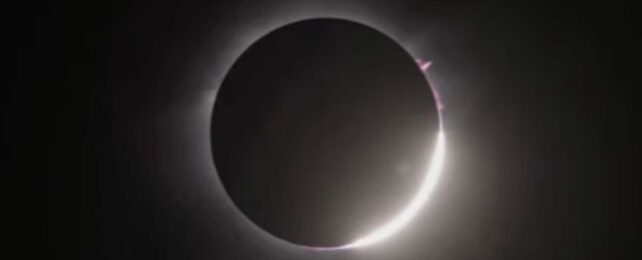For close to a minute on Thursday, parts of Australia went dark as the Sun was blocked out by the Moon in the country's first solar eclipse of 2023.
The rare, hybrid solar eclipse was only visible as a totality from a few cities in southeast Asia and Western Australia, but was watched by tens of thousands of people around the world via livestreams (including a few ScienceAlert staff based in Australia, who had views of the partial eclipse through a veil of drifting clouds in Melbourne and Sydney).
A total solar eclipse occurs when the Moon passes in front of the Sun, their alignment and scale so perfect it plunges the landscape below into an eerie darkness. For a few brief moments, all that can be seen of our parent star are the wisps of its white corona peeking shyly around the Moon's disc.
During an annular eclipse, on the other hand, the relative size of the Moon against the Sun permits a blazing ring of light to encircle the darkness.
In this case, the event was a rare hybrid total annular solar eclipse, in which the Moon's shadow touched down on one part of the eclipse track and then lifted off again as the eclipse progressed from annular to totality and back to annular again.
Photos of this rare event are now starting to flood social media, and we can't stop staring at them.
Feast your eyes on some of the images and footage of the eclipse, and take it as a timely reminder that we're all spinning on a tiny cog in a giant Solar System.
Totality from the Exmouth Gulf #SolarEclipse2023 pic.twitter.com/VBoloAPuI4
— Chris Lewis (@a_film_maker) April 20, 2023
Here's the moment of totality captured by the Perth Observatory and timeanddate.com for NASA's livestream.

And some amazing moments captured by other observers.
#SolarEclipse2023 #Perth pic.twitter.com/ZqoHf93oo8
— Liam Murphy (@_Liam_Murphy) April 20, 2023
Nice #SolarEclipse2023 pic.twitter.com/BwirUDWHGr
— Scott (@baxlex) April 20, 2023
We had a partial solar eclipse in the South West of Western Australia today. Here are my not great photos of it... wrong place, wrong gear, did what I could with what I have.#SolarEclipse2023 pic.twitter.com/FUplGxKlHn
— Paul Pichugin (@paulmp) April 20, 2023
Town Beach cheers for totality 🌚🌞 #Eclipse2023 @9NewsPerth pic.twitter.com/VIiEmJbceN
— Tracy Vo (@Tracy_Vo) April 20, 2023
Unreal. #Eclipse pic.twitter.com/4fiXcWDCPW
— Tom Fee (@thomfee) April 20, 2023
The video below demonstrates a quick and easy way to safely view an eclipse – with a pinhole camera.
From what I learned in science class… saving eyes, and vindicating my nerdiness🤓#SolarEclipse2023 pic.twitter.com/pTMst338im
— Charles Jenkinson (@charlesj_au) April 20, 2023
And just for a change of perspective, here's more of a Moon's eye view – with an Australian weather satellite showing the darkness spread across the western expanse of Australia.
Looking back the other way... #Himawari #SolarEclipse2023 pic.twitter.com/bBdPc0icOw
— Nate Byrne (@SciNate) April 20, 2023
Happy sky watching!
